|
|
Post by glactus on Feb 29, 2008 3:06:37 GMT
 These multiple circular features are volcanic domes. Their appearance resembles pancakes. The cracks found in these features are the result of lava seeping through the surface and then cooling. 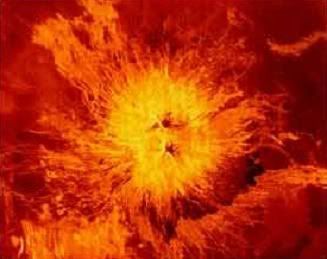 The perimeter of volcano Sapas Mons, with an elevation of 248 miles (400 kilometers) across, is scattered with numerous overlapping lava flows. The darker colored flows seem to indicate that much of the lava erupted farther away from the summit of the volcano. 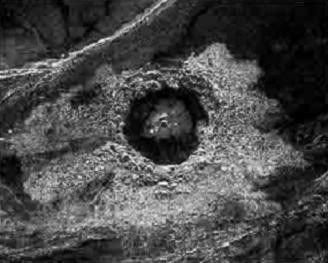 This dramatic impact crater image illustrates an unusual partial central ring. The area surrounding the crater is littered with rough, rocky material -- except from the west, which suggests the impact was made slanting in from the same direction. 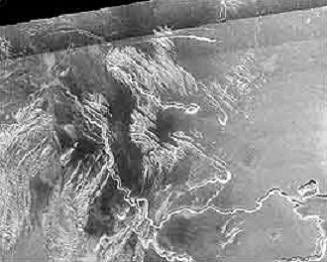 This Magellan radar image shows lava channels, flows and source areas that have collapsed over time. Part of the Venusian evolution includes volcanism, which once flooded the surface of Venus. 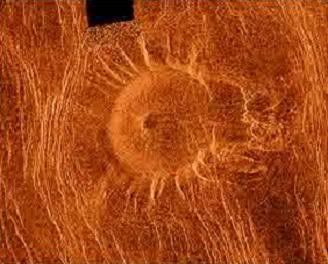 Illustrated here is a scalloped, volcanic dome called a "tick". The extensions, or ridges, may be collapsed structures. These volcanic domes, so named because of their appearance in radar images, have flat or depressed circular domes about 15 miles (25 kilometers) in diameter and are flanked by strongly defined radial ridges and troughs. About 50 have been identified. 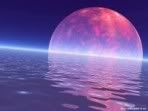 Sentinel Moon  credits: images: Nasa/JPL See images and citations at space.com multimedia: www.space.com/php/multimedia/imagegallery/igviewer.php?imgid=506&gid=38 |
|
|
|
Post by ironmountainman1 on Nov 20, 2010 19:26:42 GMT
Awesome photographs no question...
Problem is, nobody is going to visit this because the spacecraft would be built monstrously heavy like a bathysphere just to get to the surface. The annealing furnace temperatures and corrosive atmosphere would easily destroy any spacecraft that did make it to the surface. Assuming some Venusian geophysical event didn't make the situation a lot worse.
What a lot of people are missing is that Mercury gets no respect or attention insofar as a manned mission target.
If you can get to Mercury, spend a decent amount of time on the surface and make it back to earth unscathed you'll have solved any problems regarding life support and radiation hazards for the rest of the solar system.
Is there a mass obsession with Mars Mars Mars going around?
|
|
|
|
Post by starrdawg on Nov 20, 2010 20:56:21 GMT
IF it were not for the distance/time involved, the Jovian moons hold a better potential to support life than Mars, as many of the basics needed are already there.
|
|
|
|
Post by glactus on Nov 22, 2010 9:46:55 GMT
Actually You may be right Stardawg, Europa may prove to be a good candidate to have a look - see. Of course it is a moon of the Outer Planets, very far away, so just now only robotic probes are feasible.  Possible Europa ocean Just now we will have to settle for Mars. This is where all the attention will be, and what an adventure. Phobos and Demos are dead worlds though, and Mars itself will test all our skills, our level of technology and our endurance. 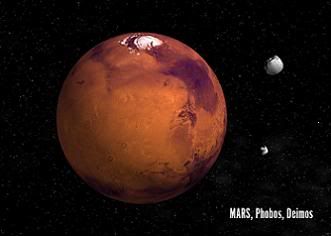 Mars Phobos Deimos. Who will get there first is anyone's guess, But wouldn't it be nice if the main super powers all went together.  Mars |
|
|
|
Post by starrdawg on Nov 22, 2010 22:12:12 GMT
robots will have to be used far in advance of any manned mission regardless where they intend to go.
The fact that outer moons already have the basic building blocks to create a "survivable" environment greatly reduce the cost of dragging such supplies or hardware around the solar system.
Pre-positioning, either on-orbit, or as "landers" is a given no matter where we go. It just costs less if there already are "recoverables" to work with.
|
|
|
|
Post by Andy Mac on Nov 24, 2010 23:40:38 GMT
What a lot of people are missing is that Mercury gets no respect or attention insofar as a manned mission target............. ..........Is there a mass obsession with Mars Mars Mars going around? I think that there are several reasons as to why Mars would be the front runner for any future manned mission: - Mars is closer to the Earth than Mercury is - It is known that Mercury is a dead world, having long since been stripped of any atmosphere by the Sun. A mission to Mercury has no doubt been deemed as not worthwhile in terms of any additional information derived from such a costly venture. Also, with the constant intense bombardment of solar radiation, Mercury would be a far more hostile (and therefore more dangerous) world to visit than the red planet. In addition Mars is likely to be of far greater interest to scientists, being the most 'Earth-like' planet in the solar system. No doubt it will continue to unlock its secrets for decades to come hence helping scientists to understand far more about our early solar system. I agree with RJ's comment about trips to some of Jupiter's (and Saturn's) moons being far more 'profitable' in terms of information gained from such a mission(s). Europa has long been suspected of perhaps having liquid water beneath its surface and moving out to Saturn, the moon Enceladus knocked scientists for six a few years back when they discovered water vapour being spewed from its south polar region. This, too, has led to speculation that there may also be liquid water beneath Enceladus's surface. As always, only time will tell!!........................ |
|
|
|
Post by glactus on Nov 26, 2010 8:24:31 GMT
Lets look at it this way. Obama has left the Moon to Private enterprise and whether we like it or not, there are many who agree with his line of thinking, which is - " Why should NASA spend 90 billion on doing what it did before". The bag which holds the most marbles anywhere in our Solar System is Mars, and there has been far more robotic systems, surface and orbital, sent to the Red Planet than we have sent to the Moon. In fact, there is quite a bit going on pertaining to Mars, now and in the near future. Mars will be the great cosmic adventure of the 21st century. It will offer mankind a real place in the Cosmos, the survival of the species, and the accumulation of those technologies that we will need for our journey to the stars.  Mars |
|
|
|
Post by Andy Mac on Nov 26, 2010 11:01:22 GMT
n terms of practicalities such as cost, distance, safely considerations etc. then Mars is clearly the main contender. If some of the afore-mentioned moons in this thread were at around the same distance from us (but with the same properties that they have now) as Mars, then I think that NASA would be focusing their attention on these potentially far more interesting worlds. Dunno if this DVD set is available for your region 'Down Under' Henry, but as someone who very much enjoys their 'graphics', you should add this item to your 'Christmas prezzie' list. The likes of the water vapour jet spewing from Enceladus graphic makes for compulsive viewing for people of all ages IMO.  |
|